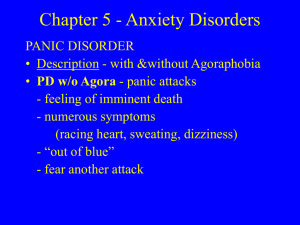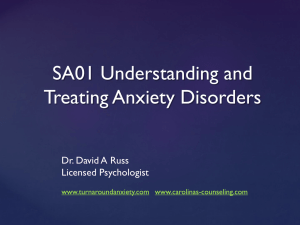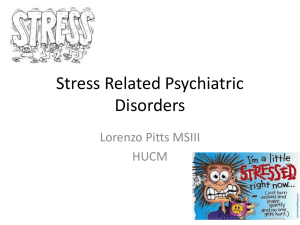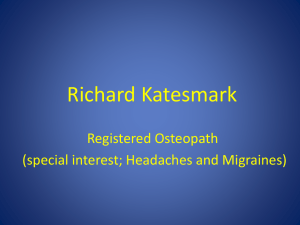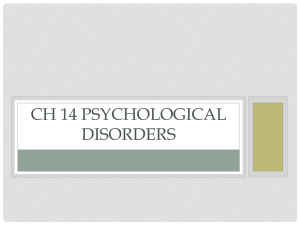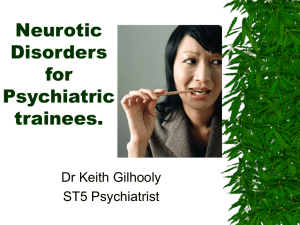Chapter Overview/Summary
advertisement
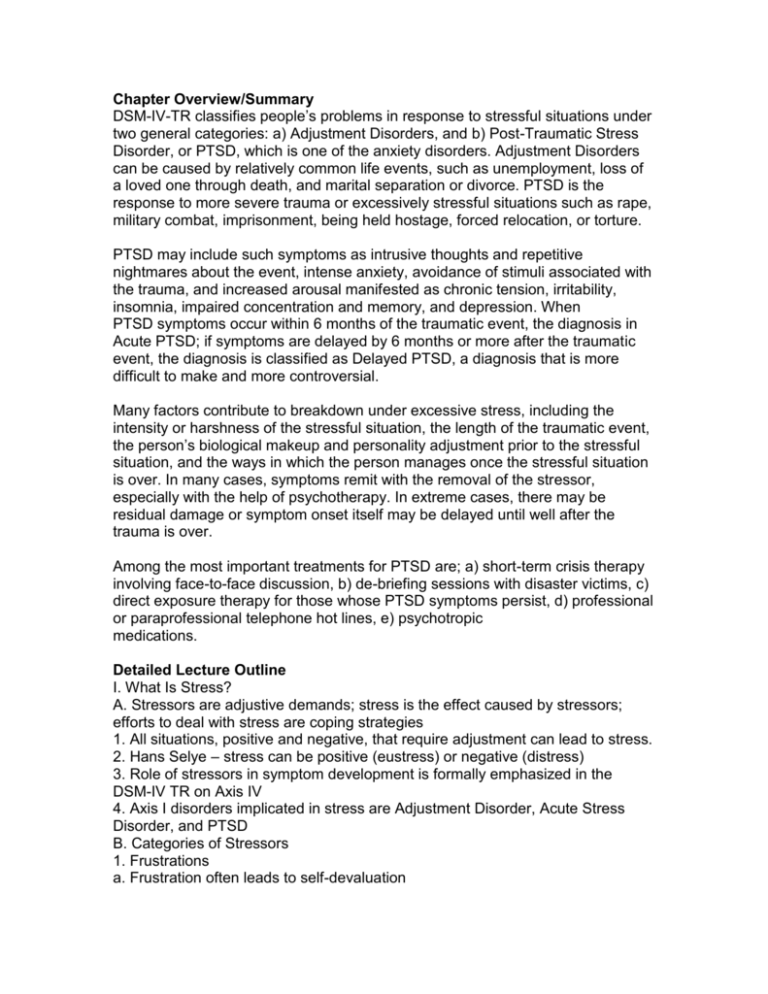
Chapter Overview/Summary DSM-IV-TR classifies people’s problems in response to stressful situations under two general categories: a) Adjustment Disorders, and b) Post-Traumatic Stress Disorder, or PTSD, which is one of the anxiety disorders. Adjustment Disorders can be caused by relatively common life events, such as unemployment, loss of a loved one through death, and marital separation or divorce. PTSD is the response to more severe trauma or excessively stressful situations such as rape, military combat, imprisonment, being held hostage, forced relocation, or torture. PTSD may include such symptoms as intrusive thoughts and repetitive nightmares about the event, intense anxiety, avoidance of stimuli associated with the trauma, and increased arousal manifested as chronic tension, irritability, insomnia, impaired concentration and memory, and depression. When PTSD symptoms occur within 6 months of the traumatic event, the diagnosis in Acute PTSD; if symptoms are delayed by 6 months or more after the traumatic event, the diagnosis is classified as Delayed PTSD, a diagnosis that is more difficult to make and more controversial. Many factors contribute to breakdown under excessive stress, including the intensity or harshness of the stressful situation, the length of the traumatic event, the person’s biological makeup and personality adjustment prior to the stressful situation, and the ways in which the person manages once the stressful situation is over. In many cases, symptoms remit with the removal of the stressor, especially with the help of psychotherapy. In extreme cases, there may be residual damage or symptom onset itself may be delayed until well after the trauma is over. Among the most important treatments for PTSD are; a) short-term crisis therapy involving face-to-face discussion, b) de-briefing sessions with disaster victims, c) direct exposure therapy for those whose PTSD symptoms persist, d) professional or paraprofessional telephone hot lines, e) psychotropic medications. Detailed Lecture Outline I. What Is Stress? A. Stressors are adjustive demands; stress is the effect caused by stressors; efforts to deal with stress are coping strategies 1. All situations, positive and negative, that require adjustment can lead to stress. 2. Hans Selye – stress can be positive (eustress) or negative (distress) 3. Role of stressors in symptom development is formally emphasized in the DSM-IV TR on Axis IV 4. Axis I disorders implicated in stress are Adjustment Disorder, Acute Stress Disorder, and PTSD B. Categories of Stressors 1. Frustrations a. Frustration often leads to self-devaluation b. External and internal obstacles can produce frustration 2. Conflicts a. Approach-avoidance conflicts b. Double-approach conflicts c. Double-avoidance conflicts 3. Pressures a. Pressures may lead a person to speed up, redouble their efforts, or change the direction of goal-oriented behavior b. External and internal sources for pressures c. Certain occupations exert numerous pressures C. Factors Predisposing a Person to Stress 1. Nature of the stressor a. The impact of the stressor depends upon importance, duration, cumulative effect, multiplicity, and imminence b. Traumatic events influence those closest to the situation 2. The experience of crisis a. Crisis occurs when stressful situations approach or exceed adaptive capacities b. Crisis intervention – providing psychological help in times of severe and special stress – may allow person to emerge from crisis stronger than before. 3. Life changes a. Even positive life changes place demands on us and thus may be stressful b. Holmes and Rahe, 1967 – Social Readjustment Rating Scale c. Horowitz, Wilner, & Alvarez, 1979 – Impact of Events Scale 4. A person’s perception of the stressor a. Same events are interpreted differently by people b. Stress is different depending upon how competent a person feels to handle the stressor c. Unanticipated stressors may place a person under severe stress d. Realistic expectations for stressful events helps e. Being able to perceive some benefit from a stressor (the silver lining) may moderate the effects of a trauma 5. The individual’s stress tolerance a. People vary greatly in overall vulnerability to stressors b. Children are particularly vulnerable c. Stress tolerance refers to a person’s ability to withstand stress without becoming severely impaired d. Early traumatic experiences can increase, or decrease, future vulnerability 6. A lack of external resources and social supports a. Positive social and family relationships can modify effects of stress b. One’s level of adjustment may be related to that of a spouse c. Many cultures offer specific rituals or courses of action that help people deal with stressful situations D. Coping With Stress 1. Coping with Stress a. Stress reactions reflect both inner factors such as a person’s frame of reference, and outer conditions, such as extreme social pressures b. Stressful situations may be intensified by the person’s cognitions c. Three interactional levels of coping with stress: (1) Biological level (2) Psychological and interpersonal level (3) Sociocultural level d. Challenges faced when coping with stress: (1) Trying to meet the requirements of the stressor (2) Protecting the self from psychological damage 2. Task-oriented coping a. Responses directed toward the stressor b. May involve overt or covert behavior aimed at making changes in one’s self, one’s surroundings, or both c. Typically more productive 3. Defense-oriented coping a. Responses protect the self from hurt and disorganization b. Two common types of responses: (1) Damage repair responses such as crying, repetitive talking, and mourning (2) Ego defense mechanisms include repression and denial c. These are often combined with task-oriented actions d. They become maladaptive when they become the predominant coping strategy or are used in extreme 4. Greve and Strobl, 2004 – Three modes of adaptation to stress a. Defensive b. Proactive c. Accomodative reactions II. The Effects of Severe Stress A. General Effects 1. When stressors are sustained or severe, a person may not be able to adapt; this lowering of adaptive efficiency is referred to as personality or psychological decompensation 2. In contrast, our reactions to stress can allow us to develop competencies that we would never have developed otherwise 3. By meeting the demands on one stressor, we may suffer a lowering of tolerance for other stressors 4. Selye, 1976 – demonstrated that successive exposure to noxious stimuli can have lethal effects on animals 5. Selye developed the term homeostasis to refer to the state in which an organism has basic biological needs met; stress disrupts homeostatic balance 6. Allostasis is the process of adaptation or achieving stability through change; this can result in wear and tear on the body and may result in lower biological resistance to disease B. Biological Effects of Stress 1. Selye’s General Adaptation Syndrome a. Alarm reaction b. Resistance c. Exhaustion 2. Stress and the sympathetic nervous system a. Cannon, 1915 – “fight-or-flight” b. Once stress response is activated, it may be difficult to deactivate c. Selye – each activation leaves an “indelible scar” d. Neurotransmitters involved when the SNS is activated – norepinephrine, epinephrine, and dopamine – have been studied and found to be elevated even after the stressful event e. Challenge studies document increased subjective distress and biological responses such as blood pressure, heart rate, and epinephrine levels f. SNS responses have been documented to have a significant impact on the individual’s cardiovascular system – increased blood pressure leads to arteriosclerotic damage in the heart and blood vessels placing the individual at risk for hypertension, heart attack, and stroke 3. Stress and the immune system a. Endocrine imbalance can be caused as stress acts through the hypothalamic-pituitary-adrenal gland, suppressing the immune system b. Probably served a protective function in the evolution of the species c. New field of psychoneuroimmunology d. Evidence indicates that lowered immune system response places people at greater risk for communicable diseases as will as mental health problems. C. Psychological Effects of Long-Term Stress 1. Alarm and mobilization 2. Resistance 3. Exhaustion III. Adjustment Disorder: Reactions to Common Life Stressors A. Diagnosed when response to a common stressor such as divorce or childbirth is maladaptive and occurs within 3 months of the stressor 1. Considered maladaptive if unable to function as usual or if reaction is excessive 2. Maladjustment will lessen when the stressor has subsided or the individual learns to adapt 3. If symptoms persist past 6 months, diagnosis will change 4. Mildest diagnosis a therapist can assign to a client B. Adjustment Disorder Caused by Bereavement 1. Accounts for about one third of all cases 2. Grief over the loss of a loved one is a natural process 3. It helps person free self for life without the other person 4. Some people do not experience normal grief 5. Grieving process typically lasts about one year 6. Complicated or prolonged grieving typically occurs in cases of unexpected deaths C. Adjustment Disorder Caused by Divorce or Separation 1. The loss of intimate an relationship is a potent stressor 2. Major source of vulnerability to psychopathology 3. The loss is a multifaceted event 4. Readjustment to life has new demands and stresses 5. Even when divorce is relatively agreeable, coping is necessary IV. Posttraumatic Stress Disorder: Reactions to Catastrophic Stressors A. Responses 1. Traumatic event is re-experienced 2. Avoidance of stimuli associated with stress 3. Increased tension/arousal, often accompanied by insomnia and sensitivity to noise 4. Impaired concentration and memory 5. Feelings of depression leading to social withdrawal B. Prevalence of PTSD in the General Population 1. Although 50% of population may experience traumatic event, only 10% of women and 5% of men develop PTSD 2. No formal diagnosis of PTSD until 1980 3. Original cases limited to war veterans and disaster victims 4. U.S. National Comorbidity study estimates the rate at about 7.8% (5% for men and 10.4% for women) 5. Greater rates in women postulated to be due to the higher rates of assaultive violence against women 6. 54% of substance abusers also had PTSD 7. 16% of people with PTSD had one other disorder; 54% had three or more diagnoses C. Distinguishing Between Acute Stress Disorder and Post-Traumatic Stress 1. Acute Stress Disorder occurs within 4 weeks of the traumatic events and lasts between 2 days and 4 weeks 2. If symptoms last longer, diagnose PTSD 3. Onset of symptoms within 6 months of event, PTSD is considered acute; onset of symptoms more than 6 months after event, considered delayed. 4. Delayed PTSD is less well defined and more difficult to diagnose. 5. Disaster syndrome may be described for many victims of major catastrophes in which great loss or public suffering has been identified a. Three stages identified (1) Shock stage (2) Suggestible Stage (3) Recovery stage – PTSD may develop during this stage b. Guilt of survivors 6. Extreme symptoms not uncommon following motor vehicle accidents 7. May be more complicated in cases of severe loss – for example, when a loved one dies during the traumatic event D. The Trauma of Rape 1. General Characteristics a. 20% of female college students report having been forced to have sexual intercourse b. Most frequent cause of PTSD in women c. Stranger rape (fear of physical harm and death) vs. acquaintance rape (fear and betrayal) d. Age and life circumstances of victim are involved in reactions to rape e. For young women, may increase conflicts over independence f. Parents may encourage victims to regress (move back home, etc) g. Vulnerability is enhanced h. Husband and boyfriend reactions may signal rejection and blaming i. Empirical evidence of five problem areas following rape (1) Physical disturbances such as hyperarousal or anxiousness (2) Emotional problems such as anxiety, depressed mood, and low self-esteem (3) Cognitive dysfunction including disturbed concentration and the experience of intrusive thoughts (4) Atypical behaviors including aggression, antisocial acts, and substance abuse (5) Interference in social relations including sexual problems, intimacy problems, and further victimization 2. Coping with rape a. Anticipatory phase – occurs prior to assault and helps victim cope b. Impact phase – paralytic effect of fear c. Post-traumatic recoil phase (1) Expressed style – feelings of fear are expressed through crying (2) Controlled style – feelings appear masked by calm facade d. Reconstitution phase (1) Self-protective activities (2) Frightening nightmares (3) Phobias 3. Long-term effects depend upon past coping skills, resiliency in dealing with problems, and level of psychological functioning 4. Counseling rape victims a. Many postpone seeking help b. Disclosure about the rape tends to have more positive and fewer negative outcomes c. Meetings with legal representatives and going to trial may temporarily reactivate the trauma of the rape E. The Trauma of Military Combat 1. The trauma of military combat a. WWI traumatic reactions were termed “shell-shocked” b. Considered to be organic conditions produced by minor brain hemorrhages c. Resulted from the general combat situation – physical fatigue, constant threat of death or mutilation, and severe psychological shocks d. During WWII, traumatic reactions known as operational fatigue and war neuroses were estimated to impact 10% of troops e. During Korean and Vietnam wars this became known as combat fatigue or combat exhaustion f. Figures were greater than officially reported – many soldiers received supportive therapy in their battalion and immediately returned to combat g. The trauma of military combat produced the greatest loss of personnel during WWII h. Among Gulf War veterans, prevalence estimated at 12.1% compared with only 4.3% of non-Gulf War veterans i. Recent reports of veterans of Afghanistan and Iraq, suggest prevalence rate of 15.6% to 17.1% after duty in Iraq compared to 11.2% from duty in Afghanistan j. Rates of disorder increase with the reported extent of combat and with being wounded in combat 2. Clinical picture in combat-related stress a. Symptoms vary considerably depending on type of duty, the severity and nature of the traumatic experience, and the personality of the individual b. Civilians living in war zones are also at risk for PTSD c. Participation in abusive violence highly associated with more severe pathologies d. Soldiers involved in grave registration duties had high rates of PTSD e. Uniformity in clinical picture is apparent (1) First symptoms are increasing irritability and sensitivity, sleep disturbances, and often-recurrent nightmares (2) Anger and control problems are a strong component f. Wounds, except in cases of permanent mutilation, led to less PTSD as they seem to provide a socially acceptable escape form stressful combat situations 3. Prisoners of war and Holocaust survivors a. Almost 40% of the American prisoners in Japanese POW camps during WWI died; even higher proportion of prisoners in Nazi concentration camps died b. Survivors of Nazi concentration camps sustained residual organic and psychological damage (anxiety, insomnia, headaches, irritability, depression, nightmares, impaired sexual potency, and functional diarrhea) along with lowered tolerance to any stress c. Survivors of POW camps showed impaired resistance to physical disease, low frustration tolerance, substance abuse, irritability, and emotional instability d. 50% of POWs were found to meet criteria of PTSD in the year following their release; nearly a third met PTSD criteria 40 to 50 years later e. Several studies have documented higher risk of death in those returning from war -- even years later f. Some of these effects may be due to harsh treatment and malnutrition F. Severe Threats to Personal Safety and Security 1. The trauma of forced migration a. Refugees forced to leave familiar surroundings b. Refugee hardships from such countries as Vietnam, Cuba, Poland, and Cambodia c. Many experience problems in acculturation d. Adjustment problems continue even after ten years in the United States e. Children of refugees may experience unique stressors as they may be living with distant relatives 2. The trauma of being held hostage a. Hostage-taking can produce disabling symptoms in victims b. Case example of Mr. A -- a man robbed and abducted 3. Psychological trauma among victims of torture a. Intense suffering and lifelong dread may result from torture b. 38% of Burmese political dissidents who escaped to Thailand had been tortured before their escape c. Many studies have unrepresentative samples and cannot be generalized d. Recent study of African refugees from Somalia and Ethiopia was able to obtain a substantial representative sample (1) 45% of men and 43% of women were tortured (2) 55% of Ethiopians and 36% of Somalians were tortured e. Psychological symptoms have been well documented, including night terrors, nightmares, depression, suspiciousness, social withdrawal and alienation, irritability, and aggressiveness f. Cognitive control (being able to predict and ready themselves for the pain) of situations reduces negative consequences G. Causal Factors in Post-Traumatic Stress 1. Level of stress and personality variables account for development of PTSD – at high enough stress levels, almost everyone will develop symptoms 2. Those who work with people undergoing traumatic events, such as police officers and aid workers, also are at high risk for developing symptoms 3. Conditioned fear – the fear associated with the traumatic experience – appears to be a key causal factor 4. Prompt treatment following a traumatic event can prevent this conditioned fear from establishing itself and becoming resistant to change 5. Causal Factors in Combat Stress Problems a. In such situations, ordinary coping strategies are fairly useless b. Consistent relationship – since the Boer War – between the incidence of total killed and wounded and the number of psychiatric casualties in war c. Temperament – little actual evidence d. Psychosocial factors (1) Reductions in personal freedom (2) Frustrations (3) Separation from home and loved ones (4) Constant fear (5) Prolonged harsh conditions (6) Unpredictability (7) Necessity of killing (8) Personal immaturity – sometimes stemming from parental overprotection (9) Past personality instability e. Sociocultural factors (1) Clarity and acceptability of war goals (2) Identification with combat unit (3) Esprit de corps – influence morale and adjustment to extreme circumstances (4) Leadership quality (5) Returning to an unaccepting social environment can increase a soldier’s vulnerability to post-traumatic stress (6) Families of returning soldiers can develop secondary traumatic stress responses H. Long-Term Effects of Post-Traumatic Stress 1. Symptoms may persist for a sustained period 2. Delayed PTSD somewhat controversial a. Difficult to relate directly to combat stress as they may have had other adjustment problems. b. Increased diagnosis may reflect increased popularity more than increased incidence. V. Prevention and Treatment of Stress Disorders A. Prevention of Stress Disorders 1. “Stress – inoculation” using cognitive-behavioral techniques can be effective in cases where the person is facing a known traumatic event. a. Information provided about the stressful situation and ways peoples can cope with dangers. b. Self-statements promoting effective adaptation are rehearsed c. Person practices self-statements while being exposed to a variety of egothreatening or pain-threatening stressors – allows person to practice the new coping skills. 2. Can’t prepare for most traumatic situations as they are unpredictable and uncontrollable. B. Treatment for Stress Disorders 1. Short-term crisis therapy involving face-to-face discussion and an active therapist 2. Postdisaster debriefing sessions have increased over the past 20 years 3. Direct exposure therapy for continuing symptoms a. Behaviorally oriented techniques involving repeated or extended exposure, either in vivo or in the imagination, to objectively harmless but feared stimuli b. Relaxation training and assertiveness training may also be recommended 4. Telephone hotlines 5. Psychotropic medications a. Antidepressants may be helpful in alleviating symptoms of depression, intrusive thoughts, and avoidance b. Since symptoms fluctuate, medication needs to be closely monitored C. Challenges in Studying Crisis Victims D. What We Are Learning about Crisis Intervention 1. Treatment immediately following the traumatic event significantly reduced PTSD symptoms 2. Post-disaster debriefing is the most controversial a. Typically provided by individuals not trained in the mental health field b. Some believe this should be mandated c. However, single debriefing sessions have questionable effectiveness VI. Unresolved Issues: Psychotropic Medication in the Treatment of PTSD A. Use of psychotropic medications is increasing 1. Risperidone has been shown to reduce symptoms 2. Antidepressants prescribed for accompanying depression, intrusive thoughts, and avoidance. 3. Topiramate, an anti-epileptic or seizure medication, has been used to reduce intrusive memories and nightmares B. Effectiveness increased if medication is accompanied by psychotherapy C. Medications can cause side effects, over-reliance on medications, suppress the natural “warning signs,” and lull the person into a false sense of having escaped the effects of the traumatic experience. ANXIETY DISORDERS: Chapter Overview/Summary Although anxiety disorders were initially considered neuroses, this term has been largely abandoned ever since DSM-III (1980). The anxiety disorders have panic or anxiety or both at their core. Panic is a basic emotion that involves activation of the fight-or-flight response of the autonomic nervous system. Anxiety is more diffuse, including blends of high levels of negative affect, worry about possible threat or danger, and a sense that threats are unpredictable or uncontrollable. Although everyone has identifiable, rational, realistic sources of anxiety, people with anxiety disorders, by definition, have irrational sources of, and unrealistic levels of, anxiety. Mood-congruent information processing, such as attentional and interpretive biases, seem to maintain all anxiety disorders. Specific phobias are intense and irrational fears of specific objects or situations accompanied by avoidance of the feared object. Stimuli may acquire phobic properties through conditioning or other learning mechanisms or through activation of constitutional predispositions. Because stimuli such as heights and menacing animals that posed a threat to our early ancestors are better able to become the target of phobias, it is thought that we are biologically “prepared” to associate them with trauma. Social phobia involves disabling fears, or even panic attacks, in one or more social situations, usually out of fear of negative evaluation by others or fear of acting in an embarrassing or humiliating manner. Social stimuli signaling dominance and aggression from other humans, including facial expressions of anger or contempt, appear “prepared” in the evolutionary sense to elicit phobic responses. The preoccupation with negative self-evaluative thoughts characteristic of social phobia tends to interfere with the ability to interact in socially skillful ways. Panic disorder involves unexpected panic attacks that often create a sense of stark terror that usually subsides in a matter of minutes. The fear of future panic attacks is known as “anxious apprehension.” Many people with panic disorder also develop agoraphobic avoidance of situations in which they fear they might have an attack and would find it difficult to escape or would be especially embarrassing. According to the conditioning theory of panic disorder, interoceptive bodily symptoms associated with early stages of prior attacks come themselves to be able to elicit panic attacks. According to the cognitive theory of panic disorder, it is the catastrophic misinterpretation of these bodily cues that produces panic attacks, especially among those with high levels of preexisting anxiety sensitivity. Biological theories of panic disorder emphasize biochemical abnormalities in the brain as well as abnormal activity of the neurotransmitter norepinephrine and probably also serotonin. The area of the brain known as the amygdala is thought to be an especially important source of panic attacks. Generalized anxiety disorder (GAD) involves chronic and excessive worry about a number of events or activities and high levels of psychic and muscle tension. People with GAD may have extensive experience with unpredictable and/or uncontrollable life events as well as having schemas through which strange and dangerous situations promote automatic thoughts focused on possible threats. The neurobiological bases of GAD differ from those related to panic disorder, involving the neurotransmitter GABA and the limbic system of the brain. Obsessive-compulsive disorder (OCD) involves unwanted and intrusive distressing thoughts or images usually accompanied by compulsive behaviors designed to neutralize those thoughts or images. Checking and cleaning rituals are most common. Genetic, brain function imaging, and psychopharmacological studies all suggest significant biological contributions to OCD. The anxietyreducing qualities of the compulsive rituals may help maintain OCD. Medical treatments of people with anxiety disorders often include anti-anxiety and antidepressant medications. These medications suppress anxiety symptoms, have high addiction potential, and tend to be associated with high relapse rates once the medications are discontinued. Behavioral and cognitive therapies are effective for anxiety disorders. Behavior therapies involve prolonged exposure to feared situations to allow fear or anxiety to habituate. With OCD, the rituals also must be prevented following exposure to the feared situations. Cognitive therapies focus on getting clients to understand their underlying automatic thoughts, which often involve cognitive distortions such as unrealistic predictions of catastrophes that in reality are very unlikely to occur, and to change these thoughts and beliefs through cognitive restructuring. Detailed Lecture Outline I. The Fear and Anxiety Response Patterns A. Fear and panic activate the “fight or flight” response 1. Cognitive/subjective components 2. Physiological components 3. Behavioral components B. Anxiety is a complex blend of unpleasant emotions and cognitions that is both more oriented to the future and much more diffuse than fear 1. Adaptive value 2. Has cognitive/subjective, physiological, and behavioral components A. Unconditional versus learned sources of fear and anxiety 1. Conditionability of fear 2. External versus internal (interoceptive) cues II. Overview of the Anxiety Disorders A. Unrealistic and irrational fears of disabling intensity B. DSM-IV-TR recognizes 7 anxiety disorders 1. Phobic disorders – specific and social 2. Panic disorder with or without agoraphobia 3. Generalized anxiety disorder 4. Obsessive-compulsive disorder 5. Post traumatic stress disorder C. Anxiety Disorders are Relatively Common 1. Most common group of disorders among women 2. Comorbidity is typical 3. Phobias are the most common of the anxiety disorders 4. Commonalities in causes across these disorders: a. Common genetic vulnerability is the personality trait of neuroticism b. Brain structures most commonly involved are generally in the limbic system c. Most common neurotransmitters involved are GABA, norepinephrine, and serotonin d. Classical conditioning is common e. People with perceptions of lack of control over their environment and their emotions are more vulnerable 5. Commonalities across effective treatments a. Graduated exposure is the single most effective treatment b. Cognitive restructuring c. Benzodiazepines and anti-depressants III. Specific Phobias A. Blood-Injection-Injury Phobia 1. Occurs in about 3 to 4% of the population 2. Disgust is as typical a response as fear 3. Initial heart acceleration followed by drop in rate and pressure 4. Nausea, dizziness and fainting B. Age of Onset and Gender Differences in Specific Phobias 1. Common in women 2. Lifetime prevalence rate of about 12% 3. Animal, dental, and blood-injection-injury phobias begin in childhood 4. Agoraphobia and claustrophobia begin in adolescence and early adulthood C. Psychosocial Causal Factors 1. Psychodynamic view of phobia as defense against anxiety via repression of id impulses; anxiety is then displaced onto some external object or situation symbolically linked to the real object of the anxiety 2. Phobias as learned behavior a. Classical conditioning and generalization b. Direct traumatic conditioning c. Vicarious conditioning of phobic fears d. Sources of individual differences in learning of phobias (1) History of previous positive experiences reduces the likelihood of a phobia developing (2) Events during conditioning such as inescapable and uncontrollable events (3) Experiences after a conditioning event such as the inflation effect (4) Cognitive factors maintaining phobias e. Evolutionary Preparedness for the development of fears and phobias D. Genetic and Temperamental Causal Factors 1. Affect the speed and strength of conditioning of fear 2. Behavioral inhibition and fear 3. Twin studies E. Treating Specific Phobias 1. Exposure therapy 2. Participant modeling 3. Virtual reality environments 4. Cognitive and pharmacological treatments ineffective 5. Some evidence that anti-anxiety medications may interfere with the positive effects of exposure therapy. IV. Social Phobias A. Interaction of Psychosocial and Biological Causal Factors 1. Social phobias as learned behavior a. Direct or vicarious conditioning, such as experiencing or witnessing a perceived social defeat or humiliation, or being or witnessing someone else being the target of anger or criticism. b. 92% of an adult sample of those with social phobia recalled severe teasing as a child. c. Those with social phobia are also more likely to have grown up with parents who were socially isolated and avoidant. 2. Social fears and phobias in an evolutionary context a. Proposes that social phobias are a by-product of dominance hierarchies. b. Evolutionarily based predisposition 1. Genetic and temperamental factors a. Modest genetic contribution b. Behavioral inhibition 2. Perceptions of uncontrollability and unpredictability a. Lead to submissive and unassertive behavior b. Likelihood increases if person has experienced an actual social defeat c. Diminished sense of personal control that may, in part, have developed from overprotective parents 3. Cognitive variables a. Danger schemas concerning others b. Expect they will behave in an awkward and unacceptable way resulting in rejection c. Preoccupied with bodily responses and negative self-images in social situations B. Treating Social Phobias 1. Behavioral and cognitive behavioral therapy a. Exposure b. Challenge of negative, automatic thoughts 2. Antidepressants may also be effective V. Panic Disorder with and without Agoraphobia A. Panic Disorder 1. As many as 85% seek help from an emergency room or doctor’s office 2. Case of Mindy Markowitz B. Agoraphobia 1. Conceptualized as a complication of repeated panic attacks in varied situations 2. Case of John D. C. Agoraphobia without panic 1. Usually a gradually spreading fearfulness 2. Extremely rare in clinical settings D. Prevalence, Gender, and Age of Onset of Panic Disorder with and without Agoraphobia 1. Prevalence increasing with younger generations 2. Onset most common between 15-24 years 3. Twice as common in females, probably for sociocultural reasons E. Comorbidity with Other Disorders 1. High comorbidity with other anxiety disorders 2. 30-50% will experience serious depression F. The Timing of a First Panic Attack 1. Frequently follows feelings of distress or a highly stressful life situation 2. Panic attacks more common (7 to 30% of population) than panic disorder G. Biological Causal Factors 1. Genetic factors a. Only moderate heritability b. Liability is probably for panic disorder and phobias 2. Biochemical abnormalities a. Biological challenge procedures suggest that no single neurobiological mechanism is implicated b. Noradrenergic and serotonergic systems implicated c. GABA recently shown to be implicated in anticipatory anxiety 3. Panic and the brain a. Amygdala b. Abnormally sensitive fear network c. Hippocampus implicated in conditioned anxiety d. Higher cortical centers mediate cognitive symptoms H. Behavioral and Cognitive Causal Factors 1. Comprehensive learning theory of panic disorder a. “Fear of fear” hypothesis and process of interoceptive conditioning b. Anxiety conditioned to internal and external cues c. Panic attacks themselves are likely conditioned to certain internal cues d. Constitutional and experiential vulnerabilities 2. The cognitive theory of panic a. Catastrophic interpretations of bodily sensations b. Automatic thoughts become the triggers of panic c. Evidence that cognitive therapy for panic works supports the prediction that changing cognitions about bodily symptoms may reduce or prevent panic 3. Psychological explanations of results from panic provocation studies a. Catastrophic cognitions not needed in conditioning theory b. Cues can be unconscious c. Learning theory better than cognitive model at explaining nocturnal panic attacks and panic attacks that occur without any preceding negative (catastrophic) automatic thoughts 4. Anxiety sensitivity and perceived control a. Anxiety sensitivity is a trait-like belief that certain bodily sensations may have harmful consequences b. Anxiety sensitivity predicted development of spontaneous panic attacks during a highly stressful period. c. Psychological manipulations, such as having a sense of perceived control or having a “safe” person, may block panic. 5. Safety behaviors and the persistence of panic a. Disconfirmation does not occur because people with panic disorder engage in “safety behaviors” such as breathing slowly b. Safety behaviors believed to prevent catastrophe c. Safety behaviors need to stop for effective treatment 6. Cognitive biases and the maintenance of panic a. People with panic disorder interpret ambiguous bodily sensations and situations as threatening. b. Attentional bias toward threat cues c. Memory bias favoring threatening information I. Treating Panic Disorder and Agoraphobia 1. Medications a. Benzodiazepines/Anxiolytics, e.g., Xanax (1) Rapid effects (2) Addictive (3) Withdrawal must be gradual (4) Rebound panic and relapse (5) Interfere with cognitive therapy b. Antidepressants (primarily the tricyclics and the SSRIs) (1) Non-addictive (2) Slow effects – may take up to 4 weeks (3) Side-effect problems – SSRIs better tolerated (4) High relapse rates 2. Behavioral and cognitive-behavioral treatments a. Prolonged exposure effective in 60 to 75% of patients b. Interoceptive exposure c. Integrative cognitive-behavioral techniques d. Combined medication and cognitive-behavior therapy seems to always lead to greater relapse VI. Generalized Anxiety Disorder A. General Characteristics 1. Future-oriented mood state of chronic worry and “anxious apprehension” 2. Restless, easily fatigued, poor concentration, irritable, tense, indecisive 3. Worry experienced as uncontrollable 4. The “basic” anxiety disorder 5. Subtle avoidance such as procrastination and checking 6. High vigilance, muscle tension, and sleep disturbance 7. A graduate student with GAD B. Prevalence and Age of Onset 1. Relatively common 2. Twice as common in women 3. Most continue to function despite symptoms 4. Age of onset difficult to determine with as many as 60 to 80% report being anxious all their lives C. Comorbidity with Other Disorders 1. Seen with other Axis I disorders, especially other anxiety and mood disorders 2. Excessive use of tranquilizing drugs, sleeping pills, and alcohol complicates the clinical picture D. Psychosocial Causal Factors 1. The psychoanalytic viewpoint a. Unconscious conflict between id and ego b. Defenses broken down or never developed c. No object to displace upon d. Theory is not testable and has basically been abandoned 2. The role of unpredictable and uncontrollable events a. Cognitive processes associated with prior aversive events b. Unpredictability of important past events generalizes to future ones c. Lack of safety signals 3. A sense of mastery: The possibility of immunizing against anxiety a. “Master” and “yoked” infant monkeys b. “Masters” coped better with stress when older c. Suggests that early experiences with control and mastery can immunize the individual against the harmful effects of stressful situations 4. The central role of worry and its positive functions a. Five benefits of worry identified by people with GAD: superstitious avoidance of catastrophe, actual avoidance of catastrophe, avoidance of deeper emotional topics, coping and preparation, motivating device b. Suppression of emotional and aversive physiological responding may serve to reinforce the process of worry c. Worry impairs the processing of the event thereby preventing fear from being extinguished 5. The negative consequences of worry a. Worrying is itself not pleasant b. Attempts to control thoughts and images actually increase them 6. Cognitive biases for threatening information a. Attention is drawn toward threat cues b. Interpret ambiguous stimuli as threats E. Biological Causal Factors 1. Genetic factors a. Small to modest heritability b. Inherited predisposition is to neuroticism (proneness to experience negative mood states); shared with major depression 2. A functional deficiency of GABA 3. The corticotrophin-releasing hormone system and anxiety 4. Neurobiological differences between anxiety and panic a. Biology of panic and GAD are not the same b. Amygdala and fight-or-flight for fear and panic, limbic system for GAD F. Treating Generalized Anxiety Disorder 1. Benzodiazepines not as effective as believed by public 2. Busipirone is a new, non-addictive, non-sedating, but slow drug 3. Antidepressants are useful 4. Cognitive behavior therapy that involves applied muscle relaxation and cognitive restructuring is quite effective VII. Obsessive-Compulsive Disorder A. Prevalence, Age of Onset, and Comorbidity 1. Not as rare as once thought, 2.5% lifetime prevalence 2. Over 90% of those who present for treatment experience both obsessions and compulsions; if include mental rituals and compulsions, this jumps to 98% 3. Divorced and unemployed people overrepresented 4. Little or no gender difference 5. Typically begins in late adolescence or adulthood but is not uncommon in children 6. Early onset more common in boys and is usually associated with more severe symptoms 7. Gradual onset and chronic once serious 8. Depression is especially common, up to 80% may experience significant depressive symptoms 9. Body dysmorphic disorder also rather common as a comorbid disorder B. Characteristics of OCD 1. Types of obsessive thoughts a. Contamination fears, harming self or others, lack of symmetry, pathological doubt, sexual obsessions, and obsessions concerning religion or aggression b. Obsessions rarely carried out 2. Types of compulsions a. Five primary types: cleaning, checking, repeating, ordering/arranging, and counting b. Performance of act brings feeling of reduced tension and satisfaction, as well as a sense of control 3. Consistent characteristics a. Anxiety is the affective symptom b. Fear that something terrible will happen to them or to others because of them c. Compulsion reduces anxiety in the short term d. “What if” illness; this tendency to judge risks unrealistically is very common among those with OCD C. Psychosocial Causal Factors 1. The behavioral viewpoint a. Mowrer’s two-process theory of avoidance learning b. Several classic experiments have supported this theory c. Core of the most effective form of behavior therapy for OCD d. Does not explain development of obsessions or abnormal assessments of risk 2. OCD and preparedness a. Some fears have occurrence rates that seem nonrandom b. Obsessions also adaptive in evolutionary terms 3. The effects of attempting to suppress obsessive thoughts a. Thought suppression may lead to paradoxical increase in those thoughts later b. Normal and abnormal obsessions differ in degree to which they are resisted 4. Appraisals of responsibility for intrusive thoughts a. Inflated sense of responsibility may lead to thought-action fusion 5. Cognitive biases and distortions a. Problems inhibiting cognitive processing b. Predisposition to thought suppression c. Nonverbal, but not verbal, memory deficits D. Biological Causal Factors 1. Genetic influences a. Moderately high heritability b. Higher rates if sub-clinical obsessive-compulsive symptoms and ticrelated OCD included 2. Abnormalities in brain function a. Abnormally active metabolic levels in the orbital frontal cortex, caudate nucleus, and the cingulate cortex b. Brain functions normalize after behavior or pharmacotherapy c. Dysfunction of the cortico-basal-ganglionic-thalamic circuit leading to inappropriate behavioral responses that are normally inhibited 3. The role of serotonin a. Anafranil (clomipramine) and Prozac often effective b. Drugs must be taken at least 6 to 12 weeks before changes noted c. Leads to a functional decrease in availability of serotonin E. Treating Obsessive-Compulsive Disorder 1. Behavioral treatment that combines exposure and response prevention most effective 2. Success in 50 to 75% of patients; this is superior to medication 3. Serotonin-reuptake inhibitors 4. Relapse rates high (up to 90%) following medication discontinuance 5. Combining medication with behavioral treatment has not been shown to be more effective in adults; one study showed promise in children 6. Neurosurgery being investigated once again VIII. Sociocultural Causal Factors in all Anxiety Disorders A. Cultural Differences in Sources of Worry 1. Yoruba culture in Nigeria indicates three clusters of symptoms: worry, dreams, bodily complaints 2. Culturally-related syndrome in China is called Koro B. Taijin Kyofusho 1. Anxiety disorder symptoms unique to Japanese cultural patterns 2. Fear of blushing, making eye contact, emitting an offensive odor



